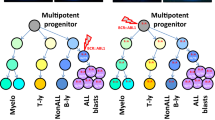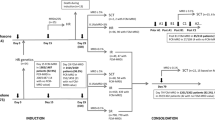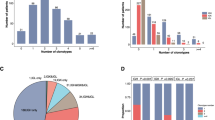Abstract
The medium-risk B cell precursor acute lymphoblastic leukemia (ALL) accounts for 50–60% of total childhood ALL and comprises the largest number of relapses still unpredictable with diagnostic criteria. To evaluate the prognostic impact of minimal residual disease (MRD) in this specific group, a case control study was performed in patients classified and treated as medium (or intermediate)-risk according to the criteria of national studies (ALL-BFM 90, DCLSG protocol ALL-8, AIEOP-ALL 91), which includes a good day 7 treatment response. Standardized polymerase chain reaction (PCR) analysis of patient-specific immunoglobulin and T cell receptor gene (TCR) rearrangements were used as targets for semi-quantitative estimation of MRD levels: ⩾10−2, 10−3, ⩽10−4. Twenty-nine relapsing ALL patients were matched with the same number of controls by using white blood cell count (WBC), age, sex, and time in first complete remission, as matching factors. MRD was evaluated at time-point 1 (end of protocol Ia of induction treatment, ie 6 weeks from diagnosis) and time-point 2 (before consolidation treatment, ie 3 months from diagnosis). MRD-based high risk patients (⩾10−3 at both time-points) were more frequently present in the relapsed cases than in controls (14 vs 2), while MRD-based low risk patients (MRD negative at both time-points) (1 vs 18) showed the opposite distribution. MRD-based high risk cases experienced a significantly higher relapse rate than all other patients, according to the estimated seven-fold increase in the odds of failure, and a much higher rate than MRD-based low risk patients (OR = 35.7; P = 0.003). Using the Cox model, the prediction of the relapse-free interval at 4 years was 44.7%, 76.4% and 97.7% according to the different MRD categories. MRD-based risk group classification demonstrate their clinical relevance within the medium-risk B cell precursor ALL which account for the largest number of unpredictable relapses, despite the current knowledge about clinical and biological characteristics at diagnosis. Therefore, MRD detection during the first 3 months of follow-up can provide the tools to target more intensive therapy to those patients at true risk of relapse.
This is a preview of subscription content, access via your institution
Access options
Subscribe to this journal
Receive 12 print issues and online access
$259.00 per year
only $21.58 per issue
Buy this article
- Purchase on Springer Link
- Instant access to full article PDF
Prices may be subject to local taxes which are calculated during checkout
Similar content being viewed by others
References
Pui C-H . Recent advances in the biology and treatment of childhood acute lymphoblastic leukemia Curr Opin Hematol 1998 5: 292–301
Reiter A, Schrappe M, Ludwig WD, Hiddemann W, Sauter S, Henze G, Zimmermann M, Lampert F, Havers W, Niethammer D, Odenwald E, Ritter J, Mann G, Welte K, Gadner H, Riehm H . Chemotherapy in 998 unselected childhood acute lymphoblastic leukemia patients. Results and conclusions of the multicenter trial ALL-BFM 86 Blood 1994 84: 3122–3133
Smith M, Arthur D, Camitta B, Carroll AJ, Crist W, Gaynon P, Gelber R, Heerema N, Korn EL, Link M, Murphy S, Pui CH, Pullen J, Reamon G, Sallan SE, Sather H, Shuster J, Simon R, Trigg M, Tubergen D, Uckun F, Ungerleider R . Uniform approach to risk classification and treatment assignment for children with acute lymphoblastic leukemia J Clin Oncol 1996 14: 18–24
Raimondi SC . Current status of cytogenetic research in childhood acute lymphoblastic leukemia Blood 1993 81: 2237–2251
Gaynon PS, Desai AA, Bostrom BC, Hutchinson RJ, Lange BJ, Nachman JB, Reaman GH, Sather HN, Steinherz PG, Trigg ME, Tubergen DG, Uckun FM . Early response to therapy and outcome in childhood acute lymphoblastic leukemia Cancer 1997 80: 1717–1726
Schrappe M, Reiter A, Riehm H . Cytoreduction and prognosis in childhood acute lymphoblastic leukemia J Clin Oncol 1996 14: 2403–2406
Childhood ALL Collaborative Group . Duration and intensity of maintenance chemotherapy in acute lymphoblastic leukemia: overview of 42 trials involving 12 000 randomised children Lancet 1996 347: 1783–1788
Schrappe M, Reiter A, Ludwig W-D, Harbott J, Zimmermann M, Hiddemann W, Niemeyer C, Henze G, Feldges A, Zintl F, Kornhuber B, Ritter J, Welte K, Gadner H, Riehm H . Improved outcome in childhood ALL despite reduced use of anthracyclines and of cranial radiotherapy. Results of trial ALL-BFM 90 Blood 2000 95: 3310–3322
Conter V, Aricò M, Valsecchi MG, Rizzari C, Testi A, Miniero R, Di Tullio MT, Lo Nigro L, Pession A, Rondelli R, Messina C, Santoro N, Mori PG, De Rossi G, Tamaro P, Silvestri D, Biondi A, Basso G, Masera G . Intensive BFM chemotherapy for childhood ALL: interim analysis of the AIEOP-ALL 91 study Haematologica 1998 83: 791–799
Kamps WA, Bökkerink JP, Hakvoort-Cammel FG, Weening RS, Verman AJ, Weeden JF, van Wering ER, van der Does-van der Berg A . Results of the DCLSG-study ALL8 (1991–1997): BFM-oriented treatment without cranial irradiation (CI) and comparing conventional oral and high doses intravenous 6-mercaptopurine Med Ped Oncol 1999 33: 169a
Wasserman R, Galili N, Ito Y, Silber JH, Reichard BA, Shane S, Womer RB, Lange B, Rovera G . Residual disease at the end of induction therapy as a predictor of relapse during therapy in childhood B-lineage acute lymphoblastic leukemia J Clin Oncol 1992 10: 1879–1888
Brisco MJ, Condon J, Hughes E, Neoh SH, Sykes PJ, Seshadri R, Toogood I, Waters K, Tauro G, Ekert H, Morley A . Outcome prediction in childhood acute lymphoblastic leukemia by molecular quantification of residual disease at the end of induction Lancet 1994 343: 196–200
Cave H, van der Werff ten Bosch J, Suciu S, Guidal C, Waterkeyn C, Otten J, Bakkus M, Thielemans K, Grandchamp B, Vilmer E . Clinical significance of minimal residual disease in childhood acute lymphoblastic leukemia New Engl J Med 1998 339: 591–598
van Dongen JJ, Seriu T, Panzer-Grumayer ER, Biondi A, Pongers-Willemse MJ, Corral L, Stolz F, Schrappe M, Masera G, Kamps WA, Gadner H, van Wering ER, Ludwig WD, Basso G, de Bruijn MA, Cazzaniga G, Hettinger K, van der Does-van den Berg A, Hop WC, Riehm H, Bartram CR . Prognostic value of minimal residual disease in acute lymphoblastic leukemia in childhood Lancet 1998 352: 1731–1738
Coustan-Smith E, Behm FG, Sanchez J, Boyett JM, Hancock ML, Raimondi SC, Rubnitz JE, Rivera GK, Sandlund JT, Pui CH, Campana D . Immunological detection of minimal residual disease in children with acute lymphoblastic leukemia Lancet 1998 351: 550–554
Marubini E, Valsecchi MG . Analysing Survival Data from Clinical Trials and Observational Studies. John Wiley Chichester 1995
Breslow NE, Day NE . Statistical Methods in Cancer Research, vol. 1: The Analysis of Case-Control Studies International Agency for Research in Cancer: London 1980
Cox DR . Regression models and life-tables (with discussion) J Roy Stat Soc 1972 34: 187–220
Pongers-Willemse MJ, Seriu T, Stolz F, d'Aniello E, Gameiro P, Pisa P, Gonzalez M, Bartram CR, Panzer-Grumayer ER, Biondi A, San Miguel JF, van Dongen JJ . Primers and protocols for standardized detection of minimal residual disease in acute lymphoblastic leukemia using immunoglobulin and T cell receptor gene rearrangements and TAL1 deletions as PCR targets: report of the BIOMED-1 Concerted Action: investigation of minimal residual disease in acute leukemia Leukemia 1999 13: 110–118
Beishuizen A, de Bruijn MA, Pongers-Willemse MJ, Verhoeven MA, van Wering ER, Hahlen K, Breit TM, de Bruin-Versteeg S, Hooijkass H, van Dongen JJ . Heterogeneity in junctional regions of immunoglobulin kappa deleting element rearrangements in B cell leukemias: a new molecular target for detection of minimal residual disease Leukemia 1997 11: 2200–2207
Rubnitz JE, Downing JR, Pui CH, Shurtleff SA, Raimondi SC, Evans WE, Head DR, Crist WM, Rivera GK, Hancock ML, Boyett JM, Buijs A, Grosveld G, Behm FG . TEL gene rearrangement in acute lymphoblastic leukemia: a new genetic marker with prognostic significance J Clin Oncol 1997 15: 1150–1157
Borkhardt A, Cazzaniga G, Viehmann S, Valsecchi MG, Ludwig WD, Burci L, Mangioni S, Schrappe M, Riehm H, Lampert F, Basso G, Masera G, Harbott J, Biondi A . Incidence and clinical relevance of TEL/AML 1 fusion genes in children with acute lymphoblastic leukemia enrolled in the German and Italia multicenter therapy trials Blood 1997 90: 571–577
Takeuchi S, Bartram CR, Miller CW, Reiter A, Seriu T, Zimmerann M, Schrappe M, Mori N, Slater J, Miyoshi I, Koeffler HP . Acute lymphoblastic leukemia of childhood. Identification of two distinct regions of deletion on the short arm of chromosome 12 in the region of TEL and KIP1 Blood 1996 87: 3368–3374
Rubnitz JE, Behm FG, Pui CH, Evans WE, Relling MV, Raimondi SC, Harrison PL, Sandlund JT, Ribeiro RC, Grosveld G, Downing JR . Genetic studies of childhood acute lymphoblastic leukemia with emphasis on p16, MLL, and ETV gene abnormalities: results of St Jude Total Therapy Study XII Leukemia 1997 11: 1210–1206
Sauerbrey A, Stammler G, Zintl F, Volm M . Expression and prognostic value of the retinoblastoma tumour suppressor gene (RB-1) in childhood acute lymphoblastic leukemia Br J Haematol 1996 94: 99–104
Nachman JB, Sather HN, Sensel MG, Trigg ME, Cherlow JM, Lukens JN, Wolff L, Uckun FM, Gaynon PS . Augmented post-induction therapy for children with high-risk acute lymphoblastic leukemia and a low response to initial therapy New Engl J Med 1998 338: 1663–1671
Acknowledgements
This work was supported by Fondazione M Tettamanti, Associazione Italiana per la Ricerca sul Cancro (AIRC) and MURST 40% (AB, ED'A and GM); by a grant from the Deutsche Krebshilfe (to CRB); by the Osterreichische Kinderkrebshilfe (ERP-G and KF), by a grant from the FWF No. P 13575-MED (to ERP-G); by Dutch Cancer Society (Koningin Wilhelmina Fonds), grant EUR 94-852 (MJW and JJMvD).
Author information
Authors and Affiliations
Rights and permissions
About this article
Cite this article
Biondi, A., Valsecchi, M., Seriu, T. et al. Molecular detection of minimal residual disease is a strong predictive factor of relapse in childhood B-lineage acute lymphoblastic leukemia with medium risk features. A case control study of the International BFM study group. Leukemia 14, 1939–1943 (2000). https://doi.org/10.1038/sj.leu.2401922
Received:
Accepted:
Published:
Issue Date:
DOI: https://doi.org/10.1038/sj.leu.2401922
Keywords
This article is cited by
-
Prospective use of molecular minimal residual disease for risk stratification in children and adolescents with acute lymphoblastic leukemia
Wiener klinische Wochenschrift (2023)
-
IgH gene rearrangement by PCR as an adjunct to flow cytometric analysis for the detection of minimal residual disease in patients with B lymphoblastic leukemia
Journal of Hematopathology (2020)
-
Improvement of overall survival after allogeneic hematopoietic stem cell transplantation for children and adolescents: a three-decade experience of a single institution
Bone Marrow Transplantation (2016)



